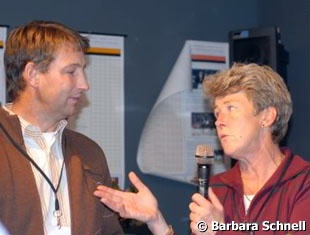
The first clinic, about cross-inspiration between dressage and jumping, was held by show jumper Franke Sloothaak and by Kyra Kyrklund, a dressage institution in her own right. She set the tone not only for her own clinic with a slide that showed the following quote:
The hand must be neither held so strict as to confine and make the horse uneasy, nor so loosely as not to let him feel it. The moment he obeys and answers it, yield the bridle to him; this will take off the stress and relieve his bars [bits], and is in conformity with that maxim, which should not be forgot, which is to caress and reward him for whatever he does well. The moment the rider perceives that the horse places his head, to go lightly in the hand, and with ease and pleasure to himself [the rider] should do nothing that is disagreeable, but flatter and coax, suffer him to rest a while, and do all he can to keep [the horse] in this happy temper. This will encourage and prepare him for greater undertakings.
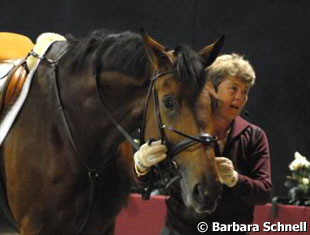 “This,” Kyra said, “was written two thousand years ago, by a man named Xenophon. So you see – there is nothing new.” Giving a brief general historical overview, Kyra recapped how with the cavalry, the biggest sponsor of equestrian sport disappeared. Private persons took over, leading to a commercialization of the sport, and to specialization in riding and in breeding.
“This,” Kyra said, “was written two thousand years ago, by a man named Xenophon. So you see – there is nothing new.” Giving a brief general historical overview, Kyra recapped how with the cavalry, the biggest sponsor of equestrian sport disappeared. Private persons took over, leading to a commercialization of the sport, and to specialization in riding and in breeding.
“Today, in riding we get specialized too early. But variation is good for a horse's health and mind. Of course different disciplines need different training. But you have to train the whole body.”
Up until getting to know her first Olympic horse, Piccolo, Kyra excelled in both dressage and jumping, but after buying Piccolo, she decided to leave her further path up to him. “I thought, whatever he does better, dressage or jumping, I will do,” she recalls. While Piccolo clearly leaned more towards dressage, his rider was happy that a career in jumping had made her more self secure. “Of course today's show jumping is very technical. Every step is accounted for, it is all about step control – short steps, long steps, slow steps, fast steps. But some jumping is a good way to improve impulsion, and it's just normal gymnastic work.”
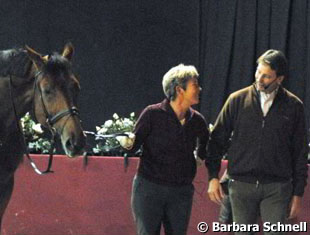 Kyra admonishes today's top young riders that their goal shouldn't only be medals, even if their time in the youngster camp is limited. Without a broad foundation, she says, the difficulties will come at the change from advanced level to Grand Prix. Young horses profit from jumping and galloping exercises as well, and Kyra also uses fences as concentration exercise for spooky horses.
Kyra admonishes today's top young riders that their goal shouldn't only be medals, even if their time in the youngster camp is limited. Without a broad foundation, she says, the difficulties will come at the change from advanced level to Grand Prix. Young horses profit from jumping and galloping exercises as well, and Kyra also uses fences as concentration exercise for spooky horses.
“Even with all the money in the world,” Kyra concluded this glimpse into her philosophy, “it's hard to find a horse that will suit you. It is much better if you're able to buy your own horse young and train him the way you want to. If you buy a foal, the trip is even longer, but it's very interesting. And if you decide to go this way, the more you have done, the bigger a tool box you have for approaching different horses. Far too often, when riders get frustrated, they have simply run out of tools.”
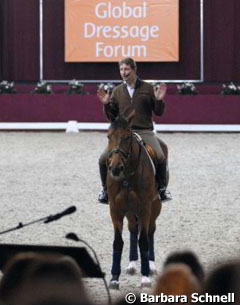 Enter Franke Sloothaak aboard Legurio. The Olympic show jumper and World Champion professed himself to be a life-long lover of dressage “because I love movement.” At the same time, he would never enter a dressage competition because of the elusive nature of the judging system. Having talked for maybe fifteen minutes, gesticulating with both hands in the saddle of his completely relaxed horse, Franke demonstrated how he uses dressage exercises to ensure that great necessity in jumping, that in the course the horse does respond to the rider's aids. Riding Legurio long, round and deep, he continued to talk with his hands, letting go of the reins while horse stayed in the desired “Drehnungshaltung” (long and deep stretching position) -- a very impressive presentation of a horse that may not be built for a dressage career, but that was entirely “through”.
Enter Franke Sloothaak aboard Legurio. The Olympic show jumper and World Champion professed himself to be a life-long lover of dressage “because I love movement.” At the same time, he would never enter a dressage competition because of the elusive nature of the judging system. Having talked for maybe fifteen minutes, gesticulating with both hands in the saddle of his completely relaxed horse, Franke demonstrated how he uses dressage exercises to ensure that great necessity in jumping, that in the course the horse does respond to the rider's aids. Riding Legurio long, round and deep, he continued to talk with his hands, letting go of the reins while horse stayed in the desired “Drehnungshaltung” (long and deep stretching position) -- a very impressive presentation of a horse that may not be built for a dressage career, but that was entirely “through”.
In the course of the following panel, international judge Stephen Clarke attested Franke that while his horse may not be built uphill enough and may not show enough impulsion, the pair excelled in harmony. “How many dressage riders do you see riding a pirouette like urgh, argh, oof – completely unlike Franke?”
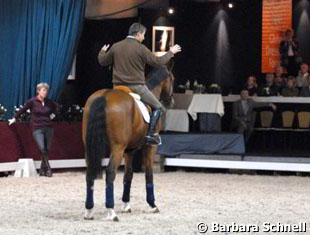 When asked about questionable practices – like the still much-discussed “Hyperflexion” -- Franke regretted “that nobody is prepared to come forward and talk.” When things go awry, “we need to react faster”, not wait months before starting to bring them to light. “And personally, for example, when youngsters come with drawreins to my clinics, I'm pleased because then I know that's how they ride at home. I also must confess that there aren't many things that I haven't tried myself – but youngsters have to try things to get experience, and as a trainer, I aim to make my pupils intelligent.”
When asked about questionable practices – like the still much-discussed “Hyperflexion” -- Franke regretted “that nobody is prepared to come forward and talk.” When things go awry, “we need to react faster”, not wait months before starting to bring them to light. “And personally, for example, when youngsters come with drawreins to my clinics, I'm pleased because then I know that's how they ride at home. I also must confess that there aren't many things that I haven't tried myself – but youngsters have to try things to get experience, and as a trainer, I aim to make my pupils intelligent.”
Photos © Barbara Schnell
Back to the 2007 GDF Index